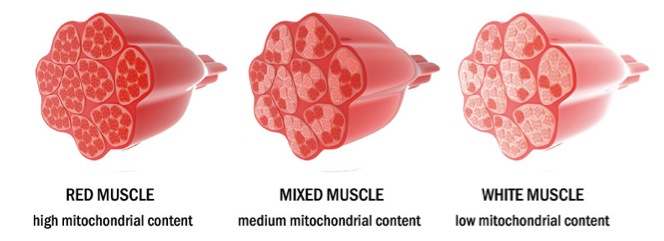Training Different Muscle Fibers for Size

All successful bodybuilders investigate their own muscle-fiber type balance in order to create an efficient weight training program to achieve maximum muscle size.
When you know your own muscle fiber make-up you're able to create an efficient training program/protocol. When you're working muscles in the wrong way you are simply cheating yourself out of your hard-earned muscle. Each muscle in our bodies is made-up of small bundles of fibers.
Each bundle has two types of fibers: fast twitch and slow twitch. Knowing the percentages of fast and slow fiber types your muscles are made of can and will help determine exactly how to train each muscle group, to ensure that you get maximum results.
Slow Twitch:
Known as red muscle fibers or Type 1, are responsible for any low intensity, long duration activity such like walking, aerobics, jogging etc.
Fast Twitch:
Known as white muscle fibers or Type 2, which are divided further into Type 2A and Type 2B. These are the muscle fibers responsible for high intensity, short-duration activity. Your Type 2B fibers are those that are built for very short, explosive type activities like the Olympic lifts. Your Type 2A fibers have been designed for any short-to- moderate duration, or moderate-to-high intensity activity/work, like one would train during most weight training sessions.
If we look at elite athletes who are at the top of their game and we look at a few extreme examples, we see glaring evidence how some endurance or marathon athletes build up to 80% of his lean body mass being slow-twitch muscle fiber. The same can be seen in some extreme examples of top fast-twitch sportsmen who have 80% or more of their lean body mass made up of fast twitch muscle fibers, making them strong and powerful but with limited endurance.
It's actually not complicated finding your own predominant fiber type in your body, we just need to test specific repetition limits of each muscle group and then compare that to its maximum strength. The first step is to establish what your own one rep maximum (1RM) is for a specific movement like doing a D/B curl.
Once you've figured out what your one rep max is, you then select a weight that's 80% of it, done by multiplying your maximum weight by 0.8, you then perform as many reps as you can using that 80% weight.
If you're only able to rep out 4 to 7 reps lifting 80% of your own 1 RM, then you have predominantly fast-twitch fibers in that specific muscle group.
If you're able to rep out 10 reps lifting 80% of your own 1 RM, then your fiber-type mix is approximately an equal 50/50 split between fast and slow twitch fiber types.
If you're able to rep out 12 to 15 or even more reps using 80% of your own 1RM, then your fiber make-up is mostly slow-twitch fibers.
One needs to be able to repeat this procedure on each muscle group that you wish to know your predominate fiber type; it will vary between different muscle groups. When you know what your predominant muscle type is, you'll be able to adjust your training accordingly. Let's take the calf muscle as an example.
The calf muscle (gastrocnemius) is made out of slow-twitch fibers primarily, but the soleus (lying underneath the gastrocnemius) is predominantly made out of fast-twitch fibers, just like the hamstrings. Weight training for muscle gain will mean working as many of your muscle-fibers as possible. When your weight training program affects more muscle fibers it means you'll get greater strength and muscle gains.
If the muscle fibers in any particular muscle group you're training consist primarily of slow-twitch fibers, you'll have to train that particular muscle group with higher reps, higher volume and shorter rest periods. Because these muscle fibers take longer to reach fatigue, they are able to recover quicker, therefore require more work in order to maximize growth.
Slow twitch-muscle fibers are severely limited in their ability to grow in size for any muscle group that is primarily made of slow-twitch. For these slow-twitch muscle groups you'll need to do lower rep training in order to maximize the fast-twitch muscle fibers that you have got in that specific muscle group you're training.
If one particular muscle group you're training doesn't grow there's a very good chance it's because there's a predominance of only slow-twitch muscle fibers. Higher reps (12 to 15 reps), more sets (higher volume) and rest periods shorter (30-60 seconds) will help you to reach a maximize size in slow-twitch muscle.
 Anabolics Mall
Anabolics Mall